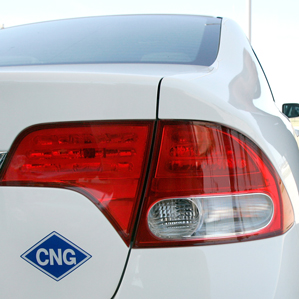New Material Makes It Easier to Store Lots of Natural Gas
Natural-gas cars remain a niche product except in a few places around the world, even though the fuel is inexpensive and burning it emits less carbon dioxide than gasoline. But new research suggests that a novel class of synthetic materials could spur more widespread adoption by making it easier and cheaper to fuel the cars and store the gas.

One obstacle forthese vehicles is that at normal temperatures and atmospheric pressure, natural gas holds much less energy than the same volume of gasoline does. A common work-around is to compress the gas and store it at high pressure, but that requires expensive fueling stations and bulky tanks that take up valuable space in the car. Compressing the gas also wastes energy.
Jeffrey Long, a professor of chemistry and chemical and biomolecular engineering at the University of California, Berkeley, and colleagues recently demonstrated a promising solution based on designer materials called metal-organic frameworks, which could allow cars to store the same amount of gas at much lower pressure.
An emerging alternative to compressed natural gas (CNG) storage is so-called adsorbed natural gas (ANG) storage, in which the tank is filled by a porous material with a large amount of surface area. The gas is stored because its molecules adhere to the material’s surface. CNG systems store gas at about 250 atmospheres of pressure, but Long says his group is aiming to design an ANG system that can store it at 35 to 65 atmospheres. Storing at 35 atmospheres would mean that people who use natural gas for heating and cooking in their homes could refuel their cars at home using a simple and inexpensive compressor, he says.
There are not yet any commercially available ANG vehicles, but there is significant interest in the technology, and it’s fairly mature. This project was supported by the U.S. Department of Energy’s Advanced Research Projects Agency-Energy, and Long’s group also received technical assistance from Ford Motor Company, which has sold nearly 60,000 CNG vehicles since 2009.
So far, however, physics has limited the range of cars using ANG systems. The challenge has been to develop a material that adsorbs gas at the target pressure of 35 atmospheres but also releases all of it before the pressure reaches five to six atmospheres, the minimum pressure at which the engine can run. In previously demonstrated systems, too much gas remains stuck in the tank and can’t be used, says Long.
To get around this, the group used “flexible” metal-organic frameworks that are unlike the rigid ones tried before in ANG systems. The materials expand after a certain pressure is reached, opening their pores to adsorb the gas during fill-up. At a lower pressure, but one slightly higher than the minimum pressure at which the engine runs, the materials collapse and push all the gas out so the engine can use it.
The new results suggest that ANG systems based on these materials could achieve higher storage capacities—and thus longer ranges—than were possible in systems that use rigid materials. It’s an important proof-of-principle, but a fair amount of engineering work is needed before systems based on materials like these could be commercialized, says Long.
Keep Reading
Most Popular
Large language models can do jaw-dropping things. But nobody knows exactly why.
And that's a problem. Figuring it out is one of the biggest scientific puzzles of our time and a crucial step towards controlling more powerful future models.
The problem with plug-in hybrids? Their drivers.
Plug-in hybrids are often sold as a transition to EVs, but new data from Europe shows we’re still underestimating the emissions they produce.
Google DeepMind’s new generative model makes Super Mario–like games from scratch
Genie learns how to control games by watching hours and hours of video. It could help train next-gen robots too.
How scientists traced a mysterious covid case back to six toilets
When wastewater surveillance turns into a hunt for a single infected individual, the ethics get tricky.
Stay connected
Get the latest updates from
MIT Technology Review
Discover special offers, top stories, upcoming events, and more.